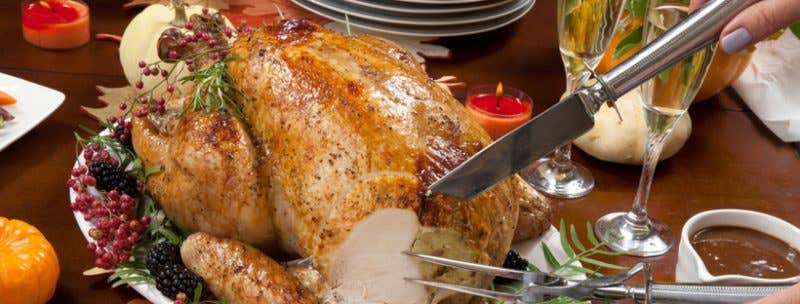Thanksgiving reins as the most bountiful holiday in America. Whether it’s smoked, roasted, or glazed, there’s a strong possibility you will indeed be serving a scrumptious turkey as your Thanksgiving dinner’s main course. However, with tradition comes the great burden of conformity. Conformity of taste. Conformity of presentation. And worst of all, conformity of expectation. Give your Thanksgiving dinner a facelift by breaking convention and pioneering a new approach to your seasonal bird.
Hold My Beer
Who knew a brewski could be the secret ingredient to basting your Thanksgiving bird from the inside out? The beer can phenomenon burst onto the Texas barbecue scene around 1995 and smoked turkey has never been the same since. With just 2 24-ounce cans of beer and spices to season, you too can enjoy the revelations of beer can turkey.
Start by preheating the grill in your outdoor kitchen area to 350° F. Remove the giblets and neck from the inner cavity of your turkey, washing the bird before drying. Brush the turkey with a beer of your choosing before seasoning with a mixture of dry mustard, garlic powder, dried onion, paprika, granulated garlic, cumin, and salt and pepper.
Next, place your turkey on an upright grilling stand with a can of beer cracked open and inserted into the bird’s cavern. For purposes of accessibility, it helps to secure your stand onto a grill safe baking sheet as you deliver it into the preheated grill. Cover the turkey with foil and roast until a thermometer inserted into the thickest part of the breast reads 180° F.
Once your turkey finishes, remove the foil and cook for five more minutes before removing from the heat and covering it again to let the juices redistribute as it rests. Serve your turkey outside as an autumn occasion, keeping any seasonal mess at bay with protective chair covers and matching outdoor furniture cover sets.
Spatchcock-a-Doodle-Do

Grilling a spatchcocked turkey reinvents your traditional Thanksgiving Day bird by utilizing a cooking method dating back to Ireland in the 1700s. “Spatchcock” is suggested to have been shorthand nomenclature for the phrase “dispatch the cock” or “kill the bird.” However, spatchcocking actually refers to the simple process of preparing poultry so it can be flattened to cook quickly and evenly over a tempered flame.
When spatchcocking, place your turkey breast side down on a cutting board. Using a pair of sharp kitchen shears, cut away and discard the backbone before flipping the bird back over to flatten. If spatchcocking on your own proves to be too difficult, you can always have your local butcher do the job for you.
It’s crucial that your turkey is brined for 24 hours before cooking. Your marinade can be something as simple as 4 tablespoons of black peppercorns gently crushed in a mortar, 8 peeled and bruised cloves of garlic, and 1 generous cup of non extra-virgin olive oil.
When the time comes to get grilling on your bird, you’re going to want to take the festivities outside onto your deck or patio. When the grill is nice and hot, lift your turkey from its marinade and cook until the flesh loses its raw pink color but is still tender with skin crisp. This process should take about 90 minutes total, on high heat. The turkey is done when both the breast and thigh read 165 °F.
As you remove the turkey from the grill, let it rest under a piece of tin foil to allow the juices to evenly redistribute within. Carve carefully, sprinkling with a healthy amount of sea salt and fresh herbs before serving outdoors on your personalized dining set cover.
On a Roulade

Achieve a true culinary feat with your Thanksgiving aspirations by remixing your turkey with a roulade. “Roulade” is derivative of the French word “rouler”, which means “to roll.” A simple roasted turkey roulade features a number of quintessential Thanksgiving flavors, all seamlessly rolled into the juicy meat of a butterflied turkey breast. For this recipe you’ll need:
- ¾ cup dried figs and ¾ cup dried cranberries
- ½ cup of pear liqueur
- ½ stick of unsalted butter
- 2 onions, diced
- 3 celery stalks
- ¾ pound sweet and spicy pork sausage
- 1 tablespoon of fresh rosemary leaves
- 2 tablespoons toasted pine nuts
- 3 cups prepackaged stuffing mix
- 1 ½ cups of chicken stock
- 1 large egg
- Kosher salt and freshly ground black pepper
- 5 pound turkey breast, boned, butterflied, and halved
Start by removing the stems from your figs, giving them a rough chopping before putting them in a medium saucepan along with the dried cranberries. Add ½ a cup of pear liqueur, along with ½ a cup of water over medium heat, and bring to a boil before lowering the heat and letting simmer for 2 minutes.
Melt half a stick of butter in a large saute pan over medium to high heat. Add finely chopped onion and celery and saute for about 5 minutes or until soft. Crumble the sausage into small bits as you add it to the pan, stirring frequently for around 10 minutes or until brown. Add the figs and cranberries mixed with chopped rosemary and pine nuts, cooking for 3 more minutes before removing from the heat.
Next, combine your pre-packaged stuffing with your sausage mixture in a large mixing bowl along with the chicken stock, 1 egg for binding, and salt and pepper. Spread the stuffing in a thick, ½ layer across your butterflied turkey breast, skin side down. Roll the turkey as you would with a burrito, being sure to tuck in any excess stuffing. Tie the roast firmly with kitchen twine before placing it in the oven at 325° F for 2 hours or until done.
Put Me In, Poach
Poaching your Thanksgiving turkey is a great way to invite conversation into your kitchen as you prepare the day’s big meal. Gather an assortment of fresh onion, rosemary, sage, and thyme, and lemons. You’ll also need a large stock pot to ensure your turkey has enough room to come out moist and succulent.
Place a 20-quart stock pot on your stove, filling with 3 gallons of spring water (you can use water from the tap, spring water just adds an extra hint of freshness). This should fit a turkey ranging anywhere from 12 to 18 pounds. Adjust accordingly for smaller (or larger) Thanksgiving birds. Poaching and boiling are not synonymous, making the prep of the water key in ensuring your turkey cooks properly. Start the water on high, bringing it to a near boil before reducing the temperature to medium as you place the turkey into what may now resemble a jacuzzi.
As you wait for the water to heat, take the time to prepare your turkey. Using a knife, gently separate the skin from your cleaned turkey, providing just enough room to fill with fresh herbs. Any extra herbs can be tossed into the water. Slice two lemons and place them inside the turkey along with one whole onion, peeled of its skin.
Place your turkey into the water using a heat-safe holder for proper lifting. Submerge the turkey under the water about 1” before covering with a lid and poaching for around 2 hours or until the internal temperature of the poultry reaches 165° F. Check on your turkey every so often to make sure the water stays at a poaching temperature, making adjustments to the heat source accordingly.
Fry Away with Me

It may sound dramatic but indulging in a deep-fried turkey can be a life-changing experience. Deep fry your Thanksgiving with the crisp exterior and juicy interior of this turkey, making for the most sublime flavor. While there are a few precautionary measures to take, you shouldn’t have to worry about a thing as you embrace this new Thanksgiving tradition.
Injectable marinades and dry rubs infuse your turkey with bold flavor as it takes a dip into the toil and trouble of frying oil. For this process, you’re going to want to move your cooking area into a spacious outdoor area, steering clear of your outdoor furniture cover set or chair covers and following necessary safety precautions to prevent any calls to the turkey hotline.
Start by testing for the amount of oil you’ll need by placing your turkey into a large stockpot, filling with cold water until there is about a one-inch margin above your turkey. Remove the turkey, dump the water, dry the pot thoroughly, and fill with peanut oil, heating over a portable propane burner until 400° F. Remove any giblets and bits from the cavern of your completely dethawed turkey before placing it into the bubbling oil. Never ever deep fry any part of a frozen turkey.
Be sure to pat your turkey dry with paper towels before securing it in a drain basket with the neck-end pointing down. Using a heavy-duty hook, lower the basket into the hot oil until completely submerged. Maintain an oil temperature of 350° F as your turkey fries for 3 and a ½ minutes per pound. Line a large platter with paper towels for your turkey as it comes out of the oil. Let it rest for 10 to 15 minutes before carving and serving with all the special fixings of Thanksgiving.

















Recent Comments